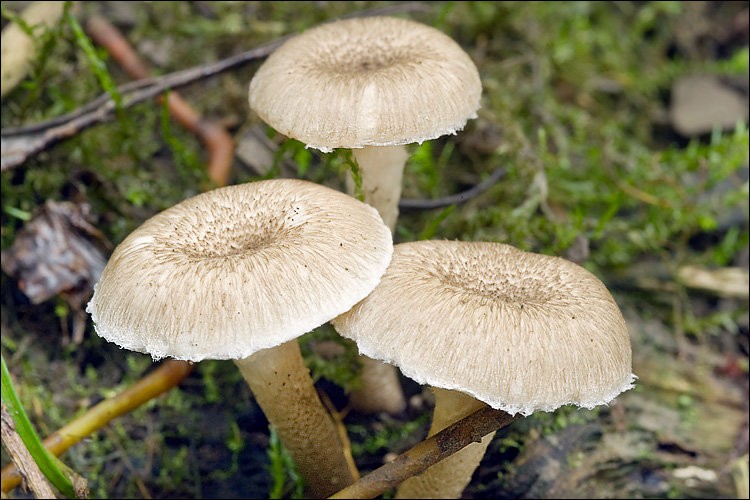Tiger sawfly (Lentinus tigrinus)
- Division: Basidiomycota (Basidiomycetes)
- Subdivision: Agaricomycotina (Agaricomycetes)
- Class: Agaricomycetes (Agaricomycetes)
- Subclass: Incertae sedis (of uncertain position)
- Order: Polyporales (Polypore)
- Family: Polyporaceae (Polyporaceae)
- Genus: Lentinus (Sawfly)
- Type: Lentinus tigrinus (tiger sawfly)
:
- Clitocybe tigrina
- A slow tiger
- Contribution in tigrinus

Mushroom Tiger sawfly, or Lentinus tigrinus, is considered a wood-destroying fungus. According to its taste properties, it is considered a conditionally edible mushroom of the third, and sometimes fourth category. It has a high protein content and excellent digestibility of the mycelium, but in adulthood it becomes quite tough.
head: 4-8 (up to 10) cm in diameter. Dry, thick, leathery. White, whitish, slightly yellowish, creamy, nutty. It is covered with concentrically arranged brown, almost black fibrous bristly scales, often darker and densely located in the center of the cap.
In young mushrooms, it is convex with a tucked edge, later it is depressed in the center, it can acquire a funnel shape, with a thin, often uneven and torn edge.
plates: descending, frequent, narrow, white, turning yellow to ocher with age, with a slightly, but quite noticeable, uneven, serrated edge.
Leg: 3-8 cm high and up to 1,5 cm wide, central or eccentric. Dense, hard, even or slightly curved. Cylindrical, narrowed towards the base, at the very bottom it can be elongated root-like and immersed in wood. It may have some kind of ring-shaped “belt” below the attachment of the plates. White at the plates, below the “girdle” – darker, brownish, brownish. Covered with small concentric, brownish, sparse scales.
Pulp: thin, dense, hard, leathery. White, whitish, sometimes turning yellow with age.
Smell and taste: no special smell and taste. Some sources indicate a “pungent” smell. Apparently, for the formation of taste and smell, it is of great importance on the stump of which particular tree the sawfly grew.
spore powder: white.
Spores 7-8×3-3,5 microns, ellipsoid, colorless, smooth.
Summer-autumn, from the end of July to September (for central Our Country). In the southern regions – from April. It grows in rather large aggregates and groups on dead wood, stumps and trunks of mainly deciduous species: oak, poplar, willow, on fruit trees. It is not common, but it does not apply to rare mushrooms.
Distributed throughout the Northern Hemisphere, the fungus is known in Europe and Asia. Tiger sawfly is harvested in the Urals, in the forests of the Far East and in the vast Siberian wild forest thickets. Feels great in forest belts, parks, on roadsides, especially in those places where mass cutting of poplars was carried out. Can grow in urban areas.
In different sources, the mushroom is indicated as edible, but with varying degrees of edibility. Information about taste is also very contradictory. Basically, the mushroom is ranked among the little-known edible mushrooms of low quality (due to the hard pulp). However, at a young age, tiger sawfly is quite suitable for eating, especially the hat. Pre-boiling is recommended. The mushroom is suitable for pickling and pickling, it can be consumed boiled or fried (after boiling) form.
In some sources, the mushroom refers to a poisonous or inedible type of mushroom. But evidence of the poisonousness of the tiger sawfly does not currently exist.









